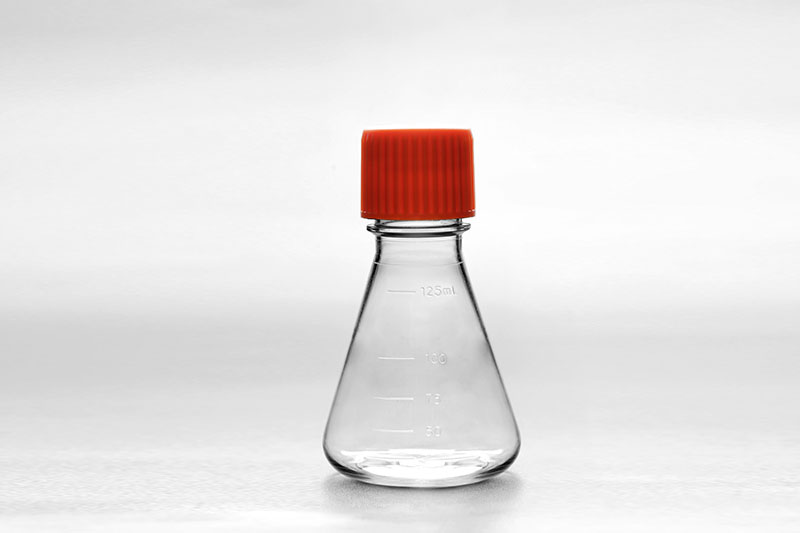Materiāli un metodes
3.1. Shake Flask Cultivations
MDCK.SUS2 suspensijas šūnu pirmskultūras tika audzētas Augšanas un infekcijas eksperimenti modeļa apstiprināšanai tika veikti, izmantojot 500 ml kratīšanas kolbas (#4113-0500, Nalgene™, Thermo Scientific, Waltham, MA, ASV) ar sākotnējo kultivēšanas tilpumu 200 ml pie 150 apgr./min. Tika veiktas divas kultivēšanas: viena viltus infekcija (1. kultivēšana), kurā šūnas auga apmēram 200 stundas, un viena infekcija (2. kultivēšana), kur šūnas tika inficētas ar IAV aptuveni 49 stundas pēc inokulācijas. Lai panāktu sinhronu šūnu populācijas infekciju, tika izmantots moi = 10. Sakarā ar relatīvi zemo šūnu koncentrāciju infekcijas laikā (2, 1 × 106 šūnas / ml) un izmantoto augsto moi, nebija nepieciešama ne barotnes aizstāšana, ne tripsīna pievienošana (vīrusa aktivācijai). Abās kultivācijās pirms paraugu ņemšanas tika pievienots sterils Milli-Q ūdens, lai kompensētu ūdens iztvaikošanu (1–2 ml dienā), jo eksperiments tika veikts nehidratētā inkubatorā. (125 ml polikarbonāta Erlenmeijera kolbās, #431143, Corning®, Ņujorkas pilsēta, NY, ASV) ar 50 ml darba tilpumu (wv) , Multitron Pro inkubatorā (Infors HT, Botmingena, Šveice) 37 °C un 5% CO2 atmosfērā ar kratīšanas frekvenci 180 apgr./min. Šūnas tika pasētas ik pēc 3–4 dienām ar sēšanas blīvumu 0,5–0,8 × 106 šūnas/ml. Inficēšanai tika izmantots IAV A/Puerto Rico/8/34 (H1N1) sēklu vīruss. adherentās MDCK šūnās (ECACC # 84121903). Sēklu vīrusa titrs bija 1,1 × 109 TCID50/mL. Šūnas tika kultivētas ķīmiski definētā, bez olbaltumvielām un dzīvnieku sastāvdaļām brīvā barotnē Smif8 (Smif8 PGD 2×, papildināta ar 5 mM glutamīnu un 8 mM piruvāts), kas īpaši izstrādāts suspensijas MDCK šūnu audzēšanai [95].
Avots no:
https:/ /www.mdpi.com/2218-1989/12/3/239/htm
Growth and infection experiments for model validation were performed using 500 mL shaking flasks (#4113-0500, Nalgene™, Thermo Scientific, Waltham, MA, USA) with an initial cultivation volume of 200 mL at 150 rpm. Two cultivations were performed, one mock-infection (Cultivation 1), where cells grew for about 200 h, and one infection (Cultivation 2), where cells were infected with IAV at about 49 h post inoculation. To achieve a synchronous infection of the cell population, a moi = 10 was used. Due to the relatively low cell concentration at time of infection (2.1 × 106 cells/mL) and the high moi used, neither medium replacement nor trypsin addition (for virus activation) was necessary. In both cultivations, sterile Milli-Q water was added before sampling to compensate for water evaporation (1–2 mL/day) since the experiment was performed in a non-hydrated incubator.
Source from: https://www.mdpi.com/2218-1989/12/3/239/htm
The FAI climbed 5.9 percent year-on-year in the first 11 months of 2018, quickening from the 5.7-percent growth in Jan-Oct, the National Bureau of Statistics (NBS) said Friday in an online statement.
The key indicator of investment, dubbed a major growth driver, hit the bottom in August and has since started to rebound steadily.
In the face of emerging economic challenges home and abroad, China has stepped up efforts to stabilize investment, in particular rolling out measures to motivate private investors and channel funds into infrastructure.
Friday's data showed private investment, accounting for more than 60 percent of the total FAI, expanded by a brisk 8.7 percent.
NBS spokesperson Mao Shengyong said funds into weak economic links registered rapid increases as investment in environmental protection and agriculture jumped 42 percent and 12.5 percent respectively, much faster than the average.
In breakdown, investment in high-tech and equipment manufacturing remained vigorous with 16.1-percent and 11.6-percent increases respectively in the first 11 months. Infrastructure investment gained 3.7 percent, staying flat. Investment in property development rose 9.7 percent, also unchanged.
 English
English



















































